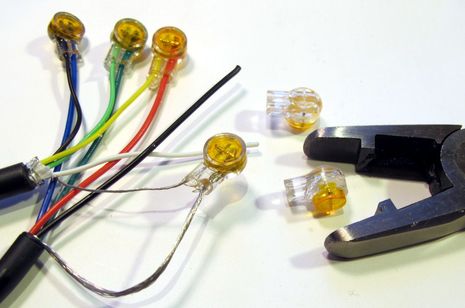Some ideas on dealing with the very small gauge wires that are used on many new electronics. From Ben at Panbo.

In October I promised to eventually discuss the 3M Scotchlok IDC connectors I used to tap into Gizmo’s engine gauge wires in order to install an Actisense EMU-1 Engine Monitoring Unit. Given that two experienced commenters already strongly dismissed these connectors for boat use, I did more research and testing. Tentative conclusion: while 3M does indeed state that Scotchloks like those tiny UY butt connectors above are meant only for 22-26 gauge solid copper conducter wires, they still seem like the fastest, surest way I’ve seen to splice the fine gauge stranded wires we often deal with afloat. Could it just be a mistake that’s kept a lot of useful Scotchlok models out of 3M’s limited marine line, or did I miss some major difference?
Let’s start at the beginning. What you need to make a lasting wire splice in the boating environment is sufficient mechanical contact between the conductors, a strong connection between the two wires so the contact isn’t broken by vibration or other physical abuse (probably abetted by some form of strain relief), and some sort of protection so that the contact surfaces don’t corrode and fail. The classic first class solution is carefully installed crimped heat shrink connectors as deeply detailed by our friend RC Collins of Compass Marine.
In October I promised to eventually discuss the 3M Scotchlok IDC connectors I used to tap into Gizmo’s engine gauge wires in order to install an Actisense EMU-1 Engine Monitoring Unit. Given that two experienced commenters already strongly dismissed these connectors for boat use, I did more research and testing. Tentative conclusion: while 3M does indeed state that Scotchloks like those tiny UY butt connectors above are meant only for 22-26 gauge solid copper conducter wires, they still seem like the fastest, surest way I’ve seen to splice the fine gauge stranded wires we often deal with afloat. Could it just be a mistake that’s kept a lot of useful Scotchlok models out of 3M’s limited marine line, or did I miss some major difference?
Let’s start at the beginning. What you need to make a lasting wire splice in the boating environment is sufficient mechanical contact between the conductors, a strong connection between the two wires so the contact isn’t broken by vibration or other physical abuse (probably abetted by some form of strain relief), and some sort of protection so that the contact surfaces don’t corrode and fail. The classic first class solution is carefully installed crimped heat shrink connectors as deeply detailed by our friend RC Collins of Compass Marine.
– See more at: http://www.panbo.com/archives/2013/12/3m_scotchloks_is_my_love_so_wrong.html#sthash.wAFwOd59.dpuf